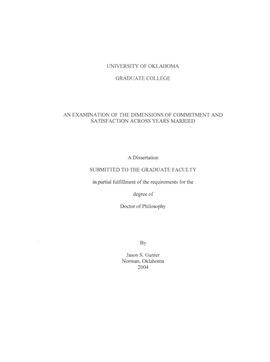| dc.contributor.advisor | Stoltenberg, Cal, | en_US |
| dc.contributor.author | Gunter, Jason S. | en_US |
| dc.date.accessioned | 2013-08-16T12:19:23Z | |
| dc.date.available | 2013-08-16T12:19:23Z | |
| dc.date.issued | 2004 | en_US |
| dc.identifier.uri | https://hdl.handle.net/11244/721 | |
| dc.description.abstract | This study built upon Adams and Jones' (1997) conceptualization of martial commitment by cross-sectionally investigating differences within and among the three dimensions of commitment and satisfaction across years married. Commitment has proven to be a meaningful construct in the study of marriage. Adams and Jones found that the various models of commitment could each be classified based on the extent to which they emphasize three distinct dimensions of commitment: attraction, morality, and constraint, respectively labeled Commitment to Spouse (CS), Commitment to Marriage (CM), and Feelings of Entrapment (FE). Previous research had not taken into account the dynamic properties of these dimensions throughout the course of marriage. This study proposed to provide greater insight into the experience of marital commitment and satisfaction in relation to years married. | en_US |
| dc.description.abstract | The study used a descriptive correlational design. Married individuals completed the Dimensions of Commitment Inventory (DCI), the Kansas Marital Satisfaction Scale (KMSS), and a demographics questionnaire. Participants were recruited from churches and from university classes. This sample of 123 individuals was currently in their first marriage and married less than 31 years. Participants were primarily middle class Caucasians. | en_US |
| dc.description.abstract | This study affirmed the conceptual uniqueness of the dimensions of commitment and illustrated how commitment is experienced in response to changes in marriage. Future research on the DCI should further explore the possible interactions between the dimensions, examining their respective causes and consequences. | en_US |
| dc.description.abstract | The hypothesized trends and interactions did not emerge. CM was the only variable that exhibited a significant trend across years married, suggesting less stability than assumed. These unexpected findings were likely influenced by the elevated commitment and satisfaction scores encountered in this sample. FE scores were particularly elevated, highlighting the ability of constraining forces to co-exist with, and possibly strengthen, positive relationship forces. Significant mean differences in commitment and satisfaction were found according to education level, gender, and the presence of children. Relationship stage variables seemed to better account for changes in commitment than the progression of years married. However, trends and interactions may only emerge in longitudinal studies. | en_US |
| dc.format.extent | vii, 126 leaves ; | en_US |
| dc.subject | Spouses Psychology. | en_US |
| dc.subject | Psychology, Clinical. | en_US |
| dc.subject | Commitment (Psychology) | en_US |
| dc.title | An examination of the dimensions of commitment and satisfaction across years married. | en_US |
| dc.type | Thesis | en_US |
| dc.thesis.degree | Ph.D. | en_US |
| dc.thesis.degreeDiscipline | Department of Educational Psychology | en_US |
| dc.note | Source: Dissertation Abstracts International, Volume: 65-02, Section: B, page: 1028. | en_US |
| dc.note | Major Professor: Cal Stoltenberg. | en_US |
| ou.identifier | (UMI)AAI3122305 | en_US |
| ou.group | Jeannine Rainbolt College of Education::Department of Educational Psychology | |
